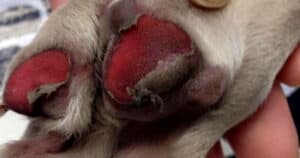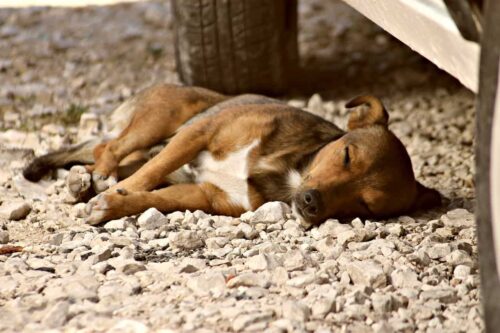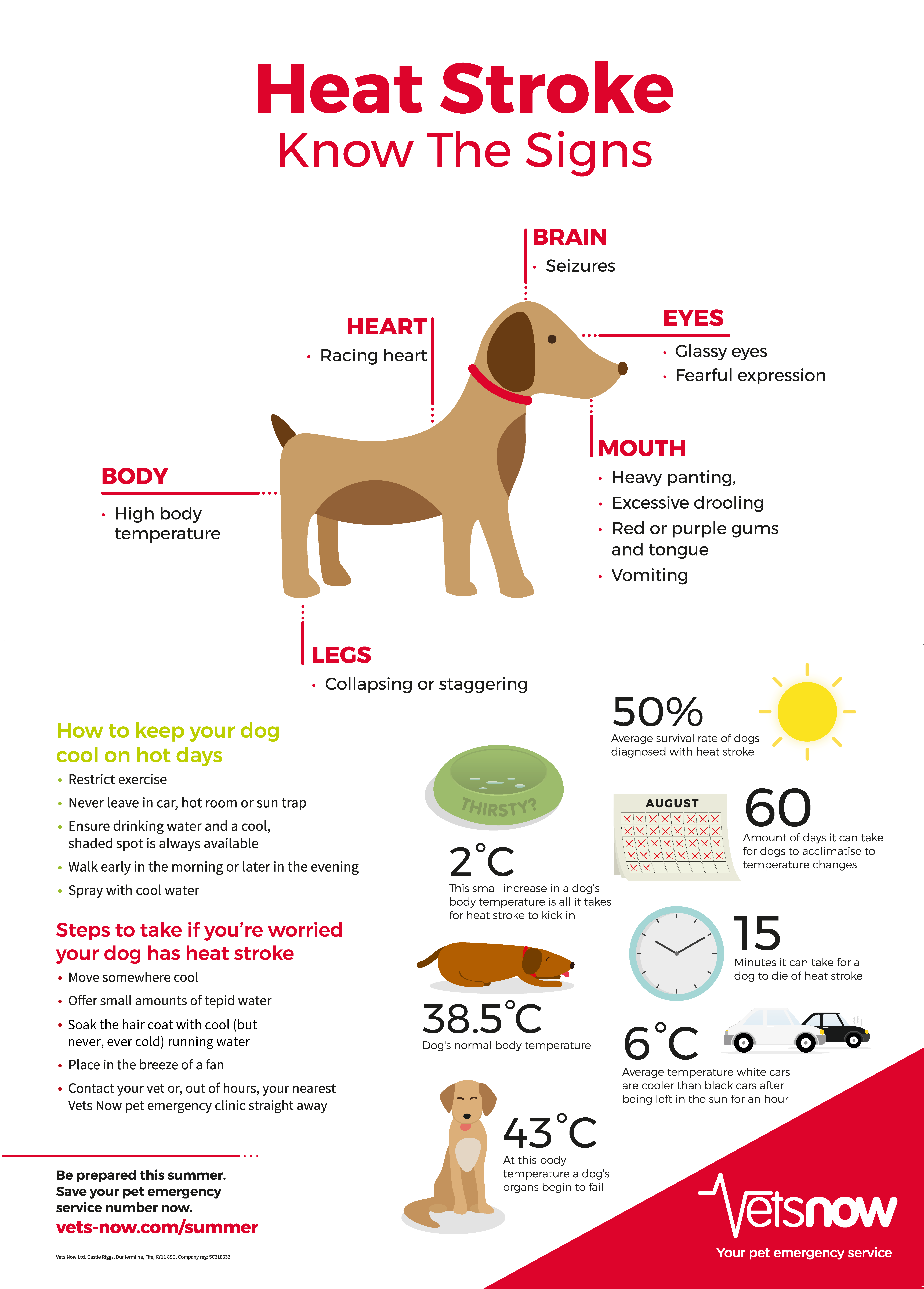Tragedy can happen to a dog when placed in a life-threatening situation on days when the temperature exceeds 20C—for example, leaving a dog in a vehicle, conservatory, hot room, outside or walking on hard surfaces. A dog’s normal temperature is around 38.5 degrees Celsius. When it increases by 2 degrees, a dog may start the first phase of heatstroke. In 15 minutes, it can be fatal or lead to permanent organ failure, decreasing overall survival. What can we do to protect our dog?

According to a veterinary practice, the mortality rate for heatstroke is 50% during mild or warm weather or being left inside hot cars or conservatories. Another emergency is burnt paw pads because dogs are walked on hot pavements, roads or sand. As harsh as I sound, being a responsible pet owner and being aware that your dog’s body reacts differently to ours can save that dog’s life. Vets-Now states that a dog is at risk of heatstroke even in temperatures of 20C to 23C. Implementing changes to outdoor patterns during certain times of the year will keep your dog safe outdoors.
And remembering unventilated hot rooms in full sun and inside a vehicle, even in the shade with or without a window opened, can kill your pet. Imagining watching your frightened dog die from a painful death and knowing you could have prevented it by rethinking walking times, keeping your dog hydrated, assessing dangerous elements in the home, and limiting vigorous playtime.
Why are temperatures a danger to dogs?
I thought I would add credibility to this article and highlight the seriousness of heat by uploading an official and approved document from Vets-Now. As you can see, it is quite startling to learn a dog can develop heatstroke in temperatures of 20C to 23C. That is 68F to 73F. It does not have to be sweltering heat for a dog to suffer.
A dog cannot sweat through the skin. They release heat through paw pads and nose and rely on panting excessively to help regulate their body temperature. Please take notice of your dog when it pants. Act and remove your dog from the situation. You may want to hydrate him, but dogs suffering from heatstroke can reject water.
A dog will not understand what is happening to it. They need us to understand the dangers and protect them, so please be vigilant for signs of distress in your dog, the home and the outdoor environment. Remember, a dog wears a fur coat, making the experience unbearable.
I recommend reading my article What to pack for your dog’s camping trip as some products are ideal for walks. For example, sunscreen for your dog.
Where can heat and sun contribute to heatstroke in dogs?
The following table shows common places where heatstroke is a risk. Remember, a dog’s temperature must only increase by 2 degrees to enter the heatstroke phase. Whether the air temperature is mild, humid, or hot doesn’t matter. A dog’s normal temperature is higher than ours. Being in specific environments can only increase their body temperature to dangerous levels.
I have mentioned vehicles and am referring to cars, vans, caravans and camper vans.
Furthermore, a dog with a thick coat will contain body heat. Keep your dog groomed. Have you considered clipping your dog’s fur at home? You can save salon costs. We now groom Teddy at home, found a great pair of clippers and filmed it for YouTube and how to secure a dog during his fur trim!
| Vehicles with or without a window open | Vehicles in full sun or shade |
| No shade in the garden, tied up outside a shop etc | Excessive outdoor playtime |
| Hairdryers | Outdoor kennels (keep sprayed with cool water) |
| Walks at peak time | Water not supplied indoors or outdoors |
| Hot room, full sun, no water | Pubs – no shade for your dog |
| Conservatory | Burnt paws on hard outdoor surfaces |
How Interior Vehicle Temperatures Can Kill Your Dog

It does not matter if a vehicle is in the shade or a window is left open – the interior will eventually heat up to furnace levels. How often have we thought that the inside of our car feels like an oven? How often have we sat in a car during the Summer waiting for a partner and sweated as in a sauna?
Imagine a dog, for all the reasons written in this article, being left in a car, wearing a fur coat, unable to sweat through the skin, body temperature accelerating, suffering because they have no option but to wait in an ‘oven’ until you return to free them.
It will likely be too late for your faithful companion fifteen minutes later.
| Outside Temperature | Temperature Inside Your Vehicle | Time It Takes To Heat Up |
|---|---|---|
| 21 degrees | 32 degrees | 10 minutes |
| 29 degrees | 40 degrees | 10 minutes |
| 21 degrees | 40 degrees | 30 minutes |
| 29 degrees | 48 degrees | 30 minutes |
| 21 degrees | 45 degrees | 60 minutes |
| 29 degrees | 53 degrees | 60 minutes |
When is the ground hot enough to burn a dog’s paw pads
Another danger for dogs is their paw pads burning. Certain types of ground cover can do this; veterinarians see more patients with severe skin burns during higher temperatures.
Vets-Now gives an example of frying an egg to show you how extreme tarmac and asphalt intensify with heat. Fry the egg for 5 minutes at 55 degrees Celsius / 131 degrees Fahrenheit and it is cooked and ready to eat.
Your dog’s paw pads can burn in 60 seconds at 52C / 125F as ground surfaces intensify with heat. Tarmac and asphalt used on roads or pavements will retain heat from increasing daytime temperatures. By 2 p.m., Vets-Now reported that the highest ground temperature would be around 60C. Burnt paw pads with skin red raw will be excruciatingly painful.
The table below gives an example of tarmac and asphalt. Please view it on a desktop.
| Outside Temperature Celsius | Outside Temperature Fahrenheit | Ground Type | Weather Conditions | Temperature of Tarmac/Asphalt in Celsius | The temperature of Tarmac / Asphalt in Fahrenheit |
|---|---|---|---|---|---|
| 25 degrees | 77 degrees | Tarmac / Asphalt | Low humidity with little wind | 52 degrees | 125 degrees |
| 30 degrees | 86 degrees | As above | As above | 57 degrees | 135 degrees |
| 30.56 degrees | 87 degrees | As above | As above | 61 degrees | 143 degrees |
What is the 7-Second Rule to test the ground heat

Press the back of your hand on the ground surface for 7 seconds. Can you hold your hand in place for seven seconds or more? Or is it too hot for you? Then it is too hot for a dog’s paw pads.
The table below explains where a dog will likely burn its paw pads.
| Concrete | Artificial grass |
| Sand | Roads & Pavements (tarmac / asphalt) |
| Brick |
Being aware of the warning signs of canine heatstroke
Tragedies can be prevented by thinking about possible dangers for a dog. The above is quite worrying.
I have seen dogs panting and drooling on walks. And certain breeds, ages, weights, and health conditions can contribute to the effects of heatstroke. When the Summer temperatures increase and our dog begins panting, his walking times are changed to protect him. Teddy has an early morning walk. It is too hot for a 4 p.m. walk, but he still goes out for a late evening walkabout. Yes, his daily outdoor time is twice instead of three times, but my partner has probably saved his life.
Never forget that excessive panting with or without drooling can strongly indicate early signs of heatstroke. This condition is severe and should not be ignored. Remember, it takes just a 2-degree increase in a dog’s body temperature for heatstroke to start, and in 15 minutes can lead to a fatality. If a dog survives, it might suffer permanent organ damage: kidney failure, brain swelling, blood clotting or intestinal bleeding.
So if you notice early signs of heatstroke, save your dog’s life and contact your vet in an emergency.
Be Responsible. Be Watchful. Act. Save Your Dog’s Life.
Preventing heatstroke in dogs
You can use preventive measures.
1: Keep your dog groomed
We bought clippers for Teddy and filmed how easy it is to groom him. You must put your dog on a lead and attach the lead to a railing or something. You might be interested in my video for a quick solution. Both videos are by Withernsea man Dave Kay
2: Walk your dog when temperatures have dropped. Vets-Now report that heatstroke occurs between 8 a.m. to 8 p.m.
3: Walk-in areas that offer shade and on surfaces that are cooler for your dog to walk on
4: Keep your dog hydrated – carry cool water and a bowl
5: Apply the 7-Second-Rule
6: Avoid vigorous playtime outdoors
7: Do not leave your dog outside without shade or water
8: Do not leave your dog in hot rooms without ventilation and keep curtains closed to block out the sun
9: Do not leave your dog in a vehicle
10: Check the temperature in the kennel – consider spraying the floor with cool water. Wooden kennels can heat up and catch fire
11: If visiting outdoor venues, remember your dog needs shade and water, and hard ground can burn their skin and advance heatstroke progression
12: In the shade, why not set up a mini pool for your dog to frolic in? Or hose him with water mist from a hose? (if you do not suspect heatstroke)
Dogs with these conditions are more prone to heatstroke:
| Elderly | Overweight |
| Heart conditions | Flat or short-nosed dogs |
| Dogs with thick fur |
These breeds are more likely to suffer heatstroke:
| Pug | Cavalier King Charles Spaniel |
| Chow Chow | Golden Retriever |
| Greyhound | Bulldog types |
Emergency help if your dog shows signs of heatstroke
Again, heatstroke is serious. It is a medical emergency and requires emergency treatment from your vet. It is better to be safe than sorry.
If your dog is showing early signs, please follow the steps below, then get your dog to a vet. Dogs can survive if treated early.
However, by ignoring the signs, you are placing your dog into a dangerous, life-threatening situation.
If you suspect heatstroke, contact your vet immediately and as an emergency.
- Move your dog out of the sun and into a shaded area
- Allow your dog to drink small amounts of cool water but slowly
- Soak a towel with tepid water and place it over your dog’s back and head, or use a fan to cool your dog
- DO NOT allow your dog to shiver when wet
- NEVER cool your dog too quickly by pouring cold water on its body
Your dog has a better chance of survival if you cool your dog before arriving at a veterinary practice. I don’t know about you, but my brain would panic. I might forget everything I have written here for fear that my dog is suffering and may die. So, I believe it is better to prevent heatstroke by keeping my dog safe in the first place.
Never use cold or ice on a dog suspected of having a heatstroke. The heat and the cold impact can cause shock.
Related questions:
What can you use if your dog’s paw pads are sore from sand, concrete or asphalt?
In the first instance, I would consult a vet. If the pads are raw, grit and other bacteria may cause infection. A vet will clean and dress the wounds and may need to prescribe medication. There are ointments and balm available online, and yes, you can clean the wounds and bandage yourself, but I believe a consultation with a professional is a starting point.
How can I protect my dog’s paw pads outdoors?
If concerned about ground heat, an option is to purchase booties. They offer protection when walking a dog, but that dog has to be willing and comfortable wearing them, and we all know how dogs and cats have a mind of their own! Training in short spells at home is necessary. I found booties available at VioVet, so see what you think. They have a pack of 12 rubber booties available. One woman put her dog’s paw in a child’s sock first then put the rubber bootie on. An alternative is the **Hurtta Outdoor Boots for outdoor activities. They have velcro fastening, so it will be easier to put on your dog – if it cooperates! Oh, each bootie has reflective strips offering visibility.
Disclaimer
I am not a veterinary professional. If you have concerns about your dog, please consult a veterinary surgeon in the first instance.
Poppys Pets is a participant in Awin and Amazon Associate affiliate programs which compensates me for referring traffic. It is of no extra cost to you and if thinking of buying a product, please consider using my link. It\'ll earn Poppy\'s Pets a few pennies to continue to this website. Only a selection of articles and videos on this website and YouTube channel contains affiliate links. Further information: Disclaimer and Privacy Policy
Poppy’s Pets has a column in an East Yorkshire newspaper


 Download this infographic from Vets Now.
Download this infographic from Vets Now.
 Download this infographic from Vets Now.
Download this infographic from Vets Now.
